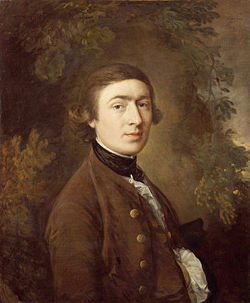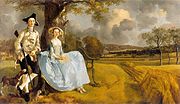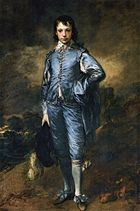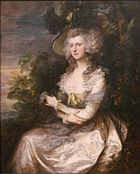
Thomas Gainsborough
About this schools Wikipedia selection
Arranging a Wikipedia selection for schools in the developing world without internet was an initiative by SOS Children. Click here for more information on SOS Children.
| Thomas Gainsborough | |
|---|---|
 Self-portrait, painted 1759 |
|
| Birth name | Thomas Gainsborough |
| Born | Sudbury, Suffolk, United Kingdom of Great Britain |
| Nationality | British |
| Field | Painter |
| Works | Mr and Mrs Andrews The Blue Boy |
Thomas Gainsborough (christened 14 May 1727 – 2 August 1788) was a British portrait and landscape painter.
Life and work
Suffolk
Thomas Gainsborough was born in Sudbury, Suffolk. He was the youngest son of John Gainsborough, a weaver and maker of woolen goods. At the age of thirteen he impressed his father with his penciling skills so that he let him go to London to study art in 1740. In London he first trained under engraver Hubert Gravelot but eventually became associated with William Hogarth and his school. One of his mentors was Francis Hayman. In those years he contributed to the decoration of what is now the Thomas Coram Foundation for Children and the supper boxes at Vauxhall Gardens.

In the 1740s, Gainsborough married Margaret Burr, an illegitimate daughter of the Duke of Beaufort, who settled a £200 annuity on the couple. The artist's work, then mainly composed of landscape paintings, was not selling very well. He returned to Sudbury in 1748–1749 and concentrated on the painting of portraits.
In 1752, he and his family, now including two daughters, moved to Ipswich. Commissions for personal portraits increased, but his clientele included mainly local merchants and squires. He had to borrow against his wife's annuity.
Bath
In 1759, Gainsborough and his family moved to Bath. There, he studied portraits by van Dyck and was eventually able to attract a better-paying high society clientele. In 1761, he began to send work to the Society of Arts exhibition in London (now the Royal Society of Arts, of which he was one of the earliest members); and from 1769 on, he submitted works to the Royal Academy's annual exhibitions. He selected portraits of well-known or notorious clients in order to attract attention. These exhibitions helped him acquire a national reputation, and he was invited to become one of the founding members of the Royal Academy in 1769. His relationship with the academy, however, was not an easy one and he stopped exhibiting his paintings there in 1773.
London
In 1774, Gainsborough and his family moved to London to live in Schomberg House, Pall Mall. In 1777, he again began to exhibit his paintings at the Royal Academy, including portraits of contemporary celebrities, such as the Duke and Duchess of Cumberland. Exhibitions of his work continued for the next six years.
In 1780, he painted the portraits of King George III and his queen and afterwards received many royal commissions. This gave him some influence with the Academy and allowed him to dictate the manner in which he wished his work to be exhibited. However, in 1783, he removed his paintings from the forthcoming exhibition and transferred them to Schomberg House.
In 1784, royal painter Allan Ramsay died and the King was obliged to give the job to Gainsborough's rival and Academy president, Joshua Reynolds. Gainsborough remained the Royal Family's favorite painter, however. At his own express wish, he was buried at St. Anne's Church, Kew, where the Family regularly worshipped.
In his later years, Gainsborough often painted relatively simple, ordinary landscapes. With Richard Wilson, he was one of the originators of the eighteenth-century British landscape school; though simultaneously, in conjunction with Sir Joshua Reynolds, he was the dominant British portraitist of the second half of the 18th century.
He died of cancer on 2 August 1788 at the age of 61 and is interred at St. Anne's Church, Kew, Surrey (located on Kew Green). He is buried next to Francis Bauer, the famous botanical illustrator.
Technique
Gainsborough was noted for the speed with which he applied his paint, and he worked more from his observations of nature (and of human nature) than from any application of formal academic rules. The poetic sensibility of his paintings caused Constable to say, "On looking at them, we find tears in our eyes and know not what brings them." He himself said, "I'm sick of portraits, and wish very much to take my viol-da-gam and walk off to some sweet village, where I can paint landskips (sic) and enjoy the fag end of life in quietness and ease."
His most famous works, such as Portrait of Mrs. Graham; Mary and Margaret: The Painter's Daughters; William Hallett and His Wife Elizabeth, nee Stephen, known as The Morning Walk; and Cottage Girl with Dog and Pitcher, display the unique individuality of his subjects.
Gainsborough's only known assistant was his nephew, Gainsborough Dupont. In the last year of his life he collaborated with John Hoppner in painting a full length portrait of Charlotte, Countess Talbot.
In fiction
- Kitty (1945) is a notable fictional film about Gainsborough, portrayed by Cecil Kellaway.
- Gainsborough has an important posthumous role in the alternate history novel The Two Georges, co-authored by Richard Dreyfuss and Harry Turtledove.



